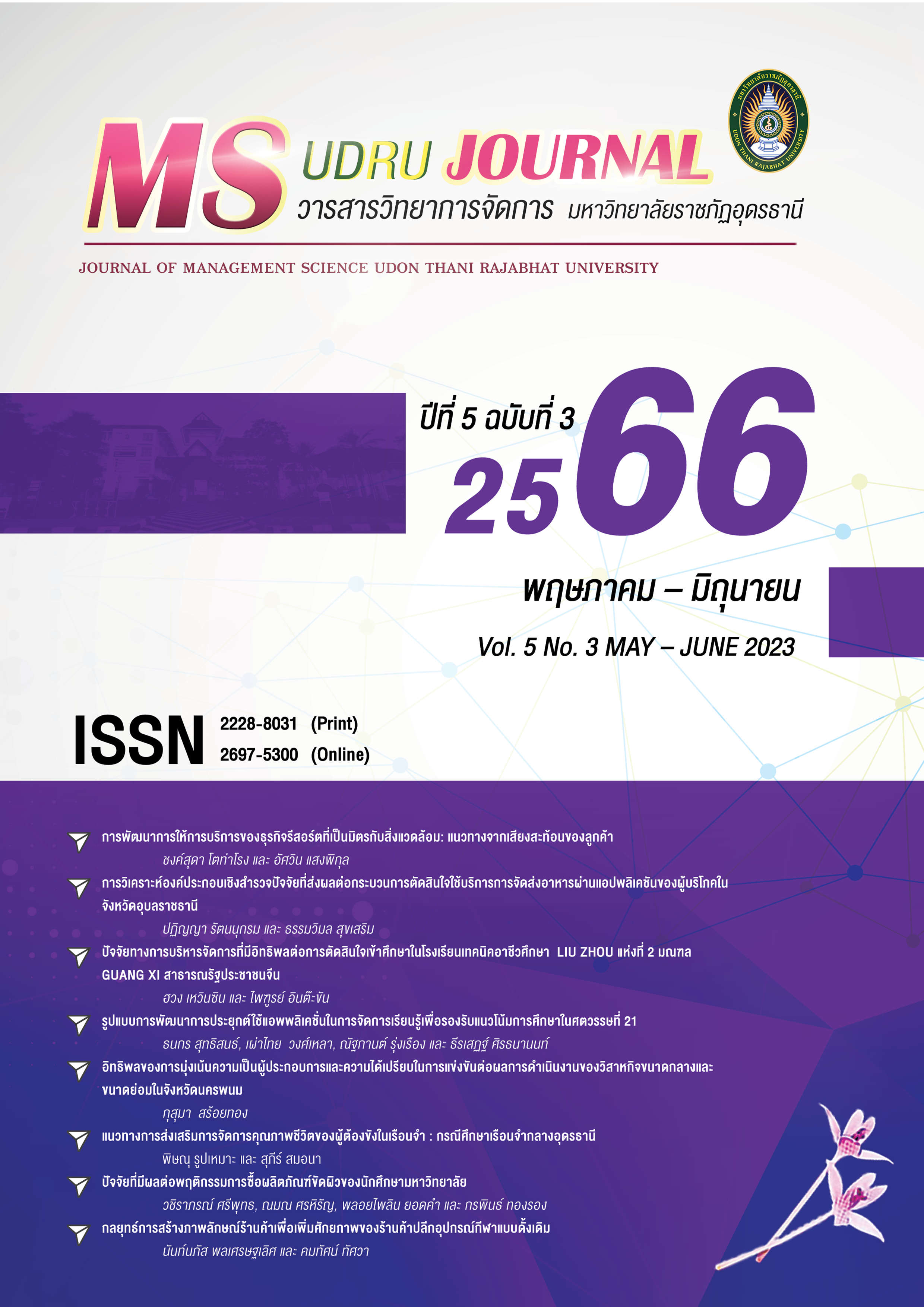THE INFLUENCE OF ENTREPRENEURIAL ORIENTATION AND COMPETITIVE ADVANTAGE ON FIRM PERFORMANCE OF SMALL AND MEDIUM ENTERPRISES IN NAKHON PHANOM PROVINCE
Main Article Content
Abstract
The objectives of this research were 1) to test an entrepreneurial orientation that affects on firm performance of Small and Medium Enterprises (SMEs) 2) to study entrepreneurial orientation that impacts competitive advantage of Small and Medium Enterprises (SMEs) and 3) to study the competitive advantages that affects on firm performance of Small and Medium Enterprises (SMEs). The researcher collected data from 155 people and used structural equation modeling to do analyses. The findings show that entrepreneurial orientations alone cannot affects firm performance directly. Therefore, entrepreneurs require competitive advantage as a crucial intermediary for further performance of SMEs. Accordingly, for SMEs to increase firm performance, the entrepreneurs should pay attention to competitive advantage with the changes and fiercely competitive.
Article Details

This work is licensed under a Creative Commons Attribution-NonCommercial-NoDerivatives 4.0 International License.
บทความที่ได้รับการตีพิมพ์เป็นลิขสิทธิ์ของคณะวิทยาการจัดการ มหาวิทยาลัยราชภัฏอุดรธานี
ข้อความที่ปรากฏในบทความแต่ละเรื่องในวารสารวิชาการเล่มนี้ ไม่ใช่ความคิดเห็นและความรับผิดชอบของผู้จัดทำ บรรณาธิการ กองบรรณาธิการ และคณะวิทยาการจัดการ มหาวิทยาลัยราชภัฏอุดรธานี ความรับผิดชอบด้านเนื้อหาและการตรวจร่างบทความแต่ละเรื่องเป็นความคิดเห็นของผู้เขียนบทความแต่ละท่าน
References
กรมพัฒนาธุรกิจการค้า. (2564). ข้อมูลนิติบุคคลรายจังหวัด. สืบค้นเมื่อ 21 เมษายน 2564, จาก https://www.dbd.go.th/more_news.php?cid=1459.
สำนักงานส่งเสริมวิสาหกิจขนาดกลางและขนาดย่อม (สสว.), 2562. SMEs กับการเข้าสู่ “ประชาคมอาเซียน” หรือ ASEAN Community. สืบค้นเมื่อ 20 พฤษภาคม 2563 จาก https://www.sme.go.th/upload/mod_download/Chapter6-20171024122349.pdf.
สุรินทร์ พิทักษ์สิกุล, สุมาลี สว่าง และ กฤษดา เชียรวัฒนสุข. (2562). รูปแบบความสำเร็จเพื่อส่งเสริมวิสาหกิจขนาดกลางและขนาดย่อม (SMEs) ในกลุ่มจังหวัดภาคเหนือของประเทศไทย.วารสารดุษฎีบัณฑิตทางสังคมศาสตร์, 9(1), 15–29.
สุวิมล ติรกานันท์. (2551). การสร้างเครื่องมือวัดตัวแปรในการวิจัยทางสังคมศาสตร์: แนวทางสู่การปฏิบัติ. กรุงเทพฯ : จุฬาลงกรณ์มหาวิทยาลัย.
วรายุ ศิรินนท์ และ ระบิล พ้นภัย. (2563). การมุ่งเน้นความเป็นผู้ประกอบการและความได้เปรียบทางการแข่งขันที่ส่งผลต่อผลการดำเนินงานของธุรกิจขนาดกลางและขนาดย่อมอุตสาหกรรมอาหารในกลุ่มจังหวัดภาคตะวันออกเฉียงเหนือตอนล่าง. วารสารชุมชนวิจัย มหาวิทยาลัย ราชภัฏนครราชสีมา, 14(1), 242-252.
Aaker, D. A., Kumar, V., & Day, G. S. (2001). Marketing Research, John Wiley&Sons. Inc. New York.
Anderson, B. S., Kreiser, P. M., Kuratko, D. F., Hornsby, J. S., & Eshima, Y. (2015). Reconceptualizing entrepreneurial orientation. Strategic management Journal, 36(10), 1579-1596.
Covin, J. G., & Wales, W. J. (2019). Crafting high-impact entrepreneurial orientation research: Some suggested guidelines. Entrepreneurship theory and practice, 43(1), 3-18.
Dess, G. G., McNamara, G., Eisner, A. B., Lee, S. H. (2019). Strategic management: Text & cases. Ninth edition. New York: McGraw-Hill Education.
Fornell, C., & Larcker, D. F. (1981). Structural equation models with unobservable variables and measurement error: Algebra and statistics.
George, D., & Mallery, M. (2010). SPSS for Windows Step by Step: A Simple Guide and Reference, 17.0 update (10th ed.) Boston: Pearson.
Hair, J., Bush, R., & Ortinau, D. (2006). Marketing Research within a changing environment (Revised international edition). New York: McGraw-Hill.
Hair, J. F. (2009). Multivariate data analysis.
Hammerschmidt, J., Eggers, F., Kraus, S., Jones, P., & Filser, M. (2020). Entrepreneurial orientation in sports entrepreneurship-a mixed methods analysis of professional soccer clubs in the German-speaking countries. International entrepreneurship and management journal, 16(3), 839-857.
Hossain, M. A., Akter, S., & Yanamandram, V. (2021). Why doesn't our value creation payoff: Unpacking customer analytics-driven value creation capability to sustain competitive advantage. Journal of Business Research, 131, 287-296.
Jiang, X., Liu, H., Fey, C., & Jiang, F. (2018). Entrepreneurial orientation, network resource acquisition, and firm performance: A network approach. Journal of Business Research, 87, 46-57.
Kaplan, R. S., & Norton, D. P. (1996). Using the balanced scorecard as a strategic management system.
Krejcie, R. V., & Morgan, D. W. (1970). Sample size recommendations. Educational and Psychological Measurement, 30, 608.
Li, S., Ragu-Nathan, B., Ragu-Nathan, T. S., & Rao, S. S. (2006). The impact of supply chain management practices on competitive advantage and organizational performance. Omega, 34(2), 107-124.
Lumpkin, G. T., & Dess, G. G. (2001). Linking two dimensions of entrepreneurial orientation to firm performance: The moderating role of environment and industry life cycle. Journal of business venturing, 16(5), 429-451.
McKenny, A. F., Aguinis, H., Short, J. C., & Anglin, A. H. (2018). What doesn’t get measured does exist: Improving the accuracy of computer-aided text analysis. Journal of Management, 44(7), 2909-2933.
MacKinnon, D. P., Fairchild, A. J., & Fritz, M. S. (2007). Mediation analysis. Annual review of psychology, 58, 593.
Mehrabi, H., Coviello, N., & Ranaweera, C. (2019). Ambidextrous marketing capabilities and performance: How and when entrepreneurial orientation makes a difference. Industrial Marketing Management, 77, 129-142.
Miller, A., & Dess, G. G. (1996). Strategic Management (2nd ed.). New York : McGraw-Hill.
Mostafiz, M. I., Hughes, M., & Sambasivan, M. (2021). Entrepreneurial orientation, competitive advantage and strategic knowledge management capability in Malaysian family firms. Journal of Knowledge Management.
Nunnally, J., & Bernstein, J. C. (1994). Psychometric Theory, 3rd Edition. New York: McGraw-Hill.
Porter, M. F. (1980). An algorithm for suffix stripping. Program.
Wales, W. J. (2016). Entrepreneurial orientation: A review and synthesis of promising research directions. International Small Business Journal, 34(1), 3-15.
Wales, W. J., Covin, J. G., & Monsen, E. (2020). Entrepreneurial orientation: The necessity of a multilevel conceptualization. Strategic Entrepreneurship Journal, 14(4), 639-660.
Wang, X., Dass, M., Arnett, D. B., & Yu, X. (2020). Understanding firms’ relative strategic emphases: An entrepreneurial orientation explanation. Industrial Marketing Management, 84, 151-164.

